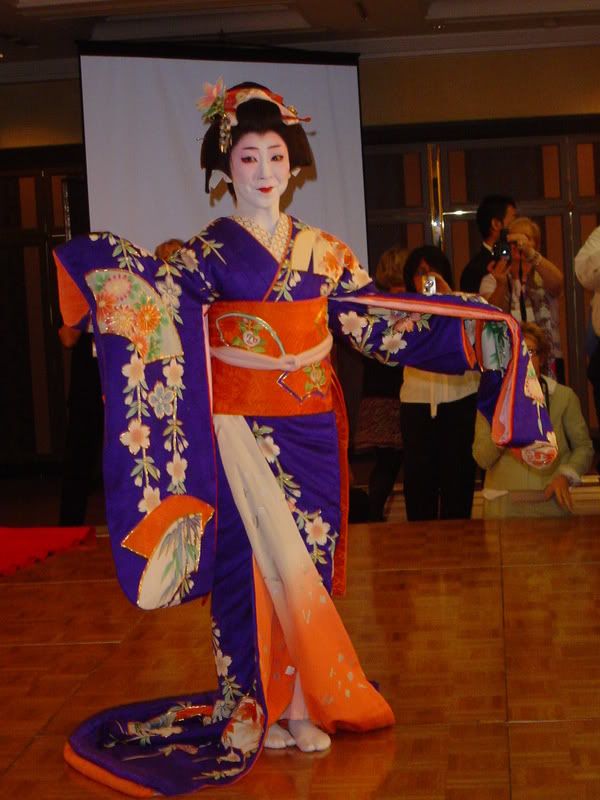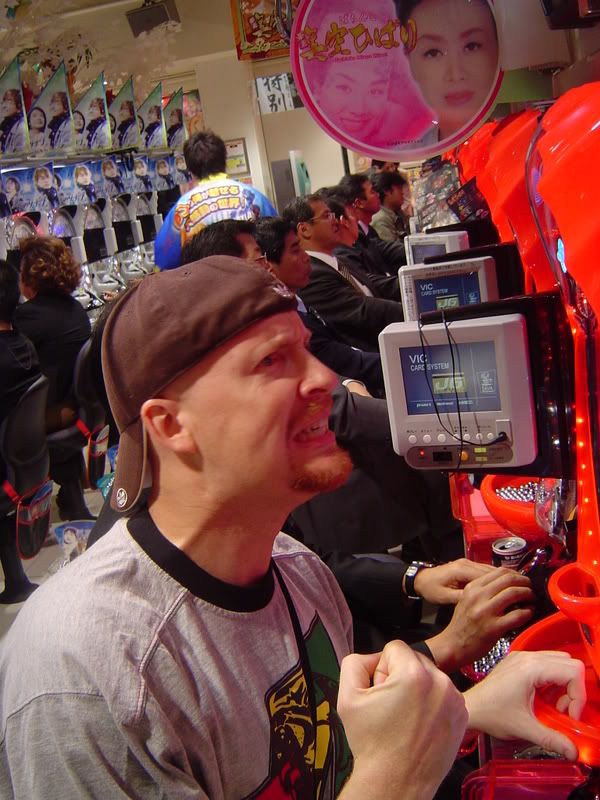10-04-06 Wednesday "Traditional Kabuki & Tossed Cookies"
WEDNESDAY, Oct 4th "Traditional Kabuki & Tossed Cookies"
I just woke up and tried on those loaned pants. What was I thinking? I cannot wear them. They are WAY WAY too big! Back to the jeans.
Today we had a great breakfast and listened to a cool speech about how the Japanese student population is starting to mirror some problems that we find currently in the states. After the speech, we had a great lunch with some Japanese cuisine and some other foods from around the world, served the best way in the world: BUFFET STYLE.
After lunch, our group went out to the Japanese Garden behind the hotel and got some great shots. One thing that was quite interesting was an ancient Japanese style bridge over a stream. In it were hundreds of coy fish, who I believe were now somewhat domesticated, due to hotel customers feeding them. Though no one was feeding them, I came up with this theory because the fish would swim right up to you and let you touch them. Looking like large gold fish, they were very beautiful and I had Victoria from our group take a photograph of yours truly trying to kiss one on the head.
Next, JMFM had two hours of traditional Japanese theater with annotations, questions and a history lesson. The first hour was Kyogen Japanese theater by an American performer named Don Kenny. Kenny performed this ancient art form exact with costumes, lines and style. The only thing he differed in was language so that we would understand the story. Kenny explained that Kyogen is very slow deliberate execution of each line. The dialogue is drawn out and choppy and seems strange that thw words are spoken as slowly as they are. The quick play had a villiage idiot (played by Kenny) going to a Sumo’s place and challenging him to a fight. Most Kyogen plays are perfomrned with 1-3 actors and the actors were theater masks much like ancient Greece. Kenny allowed us to photograph his masks. There are typically only five masks or so used in this performance art; a devil, the God of Happiness (a smiling Japanese man’s face), the younger daughter, the heavyweight older daughter that no one wants to marry.)
The second art form was “Kabuki” theater. This demonstration was brought to us by a Japanese performer named Mark Oshima. Oshima had a very interesting PowerPoint that covered the different eras that Kabuki has aged through. Kabuki theater can have many actors and is often done with an elaborate set and some very elaborate costumes and face paint. This art form is often musical with most actors singing their lines. The Japanese in this art form use a small ensemble to help express the mood of the story including a solemn sitar that helped to express the pain the female kabuki character was expressing.
During the performance of the history, a woman Kabuki actress showed us how she does her make up live on stage while the Kenny took a host role on and. This particular story had a sad subtext going on during her dance –stating that the Kabuki had lost her boyfriend. The singing was close to a lamentation at times and Don Kenny explained that a strange phonic lead was used; something that sounded like a fast high pitched A-E-I-O-U was sung at the end of words/lines to keep prolong words ( the style sung in) from blending in together and sounding like some other big word/phrase which could very easily well happen in the Japanese language.

I filmed this on my schools mini-DVD recorder along with Virginia, a TV production teacher in Miami. She is going to take my footage and inter-splice it with her own, to later give me an edited documentary of the trip.
With a two-hour break before our reception, I went and found the gym and was able to run about two miles – OR SO I THINK! A few words about the gym; it looks as if the Japanese don’t use the gym much, maybe it is a provision allotted primarily for westerners, though I am not certain. I say this because our hotel is HUGE, but there is only one treadmill, a couple of bikes and a pad. Another odd note is that the treadmill’s means of calculation and measurement was calibrated in meters, so it confused a stupid guijin like me.
For our reception & dinner a few JMFer alumni spoke about the importance of the program and how it has lasted for ten years now, even though they believed it would dissolve after completing it’s original five year vision. A toast was given by the former mayor of Minato City, Keime Haarada. I actually drank most of a red glass of wine, due to the fact that I did not want to insult the waiter who poured it for me who stood right near by. Once dinner began, buffet style again (I love it, but might get fat after 3 weeks if I don’t keep at the meter treadmill.)
It was a stand up dinner in the same place that they held the reception. That means no chairs and a few stool-like tables. We had a number of good dishes once again. I particularly enjoyed some Japanese beef strips and the pork tempura. There was also another good dish called John Dori – a fish in sauce that was particularly good.
On the way back to my room… GET THIS: Jenny, Meg and myself were in an elevator with an Indian woman. We were talking about the reception and not really paying much attention to anything when all of the sudden, the Indian woman turned her head and barfed on my only pair of pants!!!
She apologized, but the damage was done. I was gooey. When we got to floor 35, I was thoroughly grossed out from the repugnant act that was just bestowed upon me. Jenny’s room was a little down a hall and right in front of the now overly juicy elevator. Thank god, she went and opened her door so I wouldn’t have to touch anything. I had a big glob of “Double Dare” slime oozing off of my arm and hand, as well as a sizable helping of up-chuck on both my hip and pants.
Jenny described the situation by saying “it looked like the woman was just dumping water on the floor,” and that she didn’t have a clue what was happening at the time that the lady lost her lunch.
I cleaned off the yak the best that I could and hurried back to my room to soak my jeans.
After dinner Jenny, another art teacher, and a few social studies teachers went over to the pachinko area. Pachinko is a casino like game that looks like a cross between a slot machine and a pinball machine. You play it to try and win these little ball bearings that you can trade in for a metallic bar. Now here is the trick: because the government does not allow gambling, you play for a metal bar that can be traded in for a ski-ball type prize like you would get here on a beach –or- you bring the bar out to a side alley and trade the bar in for CASH. This loop hole allows for gambling and the ski-ball type prize is, for the most part, a front.

We got a few shots of the Pachinco zone. The typical pachinko hall is an obnoxiously loud place with flashing lights buzzers and bells blaring constantly at the highest of decimals with lame jingles and chimes to boot. It is a very campy smarmy area with lots of bright pinks and light blues and it was quite a surprising contrast to see that primarily it was packed with Japanese business men in sharp professional nice suits. Also in the pachinko area, we saw a Japanese McDonalds featuring the new “Filet-o-Shrimp” sandwich, a book store that had a naked tattoo book in the children literature section, and a grocery store featuring some kind of alcoholic beverage with a goat testicle in the bottle. Trying to take shots of all the different things we see can sometimes be difficult. We tried to get a shot of Jen in a psychedelic hallway of some weird restaurant you can only get to by taking a few flights down into a basement. We did get chased out of a funky hallway for taking picture.


0 Comments:
Post a Comment
<< Home